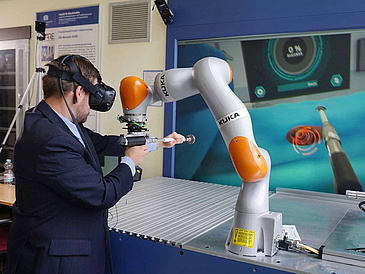The growing number of older people worldwide is leading to an increase in hip implants and other joint replacement operations. This also increases the need for highly qualified orthopedic surgeons, but the practical training of these operations is very difficult to carry out. Scientists at Chemnitz University of Technology and the University of Bremen are therefore developing a dynamic hip implant simulator in the "Dynamic HIPS" project, which officially started on 1 May 2020. The simulator will allow doctors to practice the operation multiple times and help them get a realistic feeling for the tasks.
The project focusses on three particularly critical surgical steps: the separation of the femoral head, the scraping out of the thighbone and the implantation of the artificial joint. "The system allows prospective surgeons to gain significant experience before their first real operation," explains Prof. Gabriel Zachmann from the Center for Computing Technologies (TZI) at the University of Bremen. "Experienced surgeons also benefit from this training simulator because they can prepare for complicated, rarely performed procedures."
Same sensory perceptions as in a real operation
Surgery is often performed in the smallest possible surgical openings to protect the patient. "As a result, the surgeon operates very much by feel," explains Mario Lorenz from the Chair of Machine Tools at Chemnitz University of Technology. "Operations such as the implantation of a hip prosthesis also require manual work with high forces. It is very important for the success of the operation to perform these tasks as precisely as possible. However, up to now there is a lack of training equipment that can give surgeons exactly the same sensory perceptions that they would feel during a real operation such as the resistance of the bone during sawing and scraping.”
The Dynamic HIPS project therefore pursues several goals that will make it possible to develop the necessary training devices. The researchers want to determine the forces, torques and speeds that occur during the three surgical steps to be simulated. On this basis, they want to further develop a robotic arm and existing haptic devices – devices that can convey realistic sensory perceptions. Equally important is the creation of a mathematical model that simulates the resistances and material removal at the bone. This information must be transmitted to the robot within a millisecond to give the surgeons a realistic feeling.
Experts can join training sessions from other parts of the world
A second set of objectives deals with VR technology, which enables joint training over long distances ("remote training"). With the help of a multi-user system, experienced surgeons can pass on their medical expertise to trainee surgeons without being on-site themselves. This functionality not only facilitates the transfer of knowledge to emerging and developing countries but also serves the exchange of knowledge between experienced surgeons.
Researchers face the challenge of minimizing the time delays in synchronizing VR scenes despite the large spatial distance between users so that both surgeons are in an identical situation. At the same time, the scientists want to strengthen the interaction between users in the VR environment by providing ways to communicate without words, for example by pointing to virtual 3D drawings. In the future, it should also be possible to record sequences and add audio commentary to create training videos.
Extensive user study to ensure acceptance
In addition to the University of Bremen and the Chemnitz University of Technology, the companies FAKT Software GmbH, Haption GmbH, CAT Production GmbH and YOUSE GmbH are participating in the project. Part of the consortium had already developed a training simulator for milling the hip socket in the predecessor project HIPS.
From a medical point of view, the development is being supported by the Department of Orthopaedic, Trauma and Plastic Surgery at the University Hospital Leipzig, the Center for Research on Musculoskeletal Systems (ZESBO), the Division of Macroscopic and Clinical Anatomy at the Medical University of Graz (Austria) and the Medical Technology Department of the Fraunhofer Institute for Machine Tools and Forming Technology (IWU).
The entire development process in Dynamic HIPS is user-centric. Orthopedic surgeons are involved in determining the system’s desired characteristics and participate in designing and evaluating the solutions. The final project phase also includes an extensive user study. The three-year project is funded by the German Federal Ministry of Education and Research with over 2 million euros.


